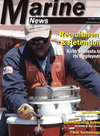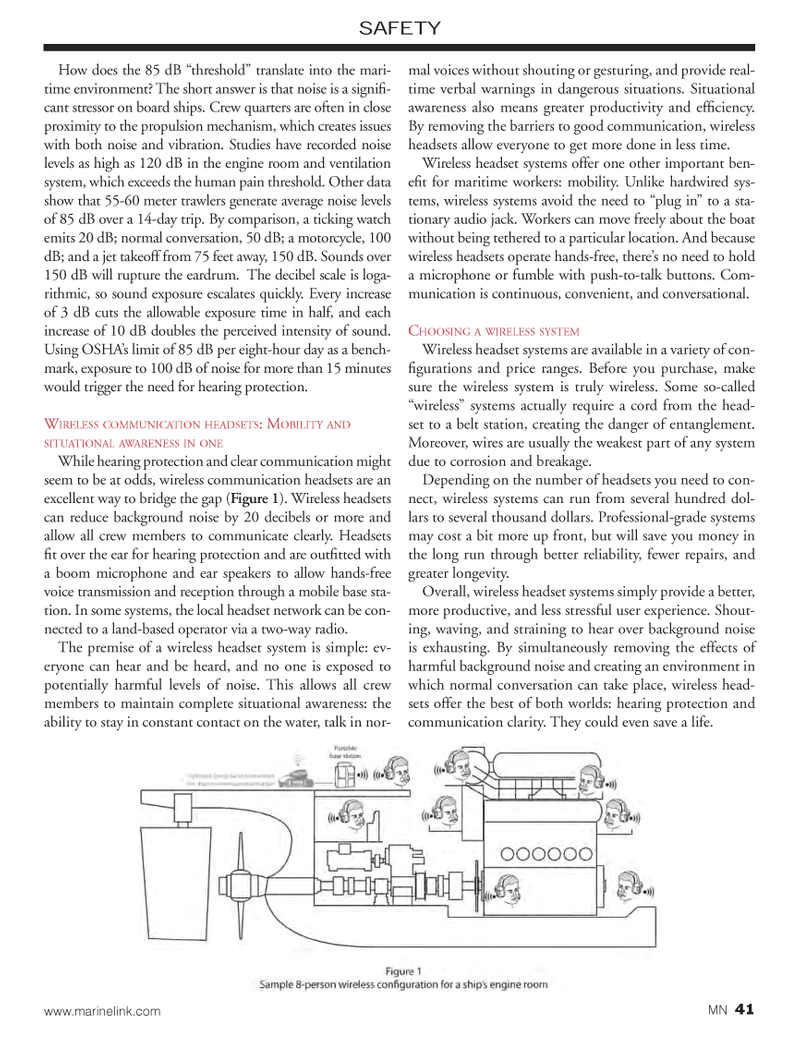
Page 41: of Marine News Magazine (October 2013)
Manning: Recruitment & Retention
Read this page in Pdf, Flash or Html5 edition of October 2013 Marine News Magazine
How does the 85 dB ?threshold? translate into the mari- time environment? The short answer is that noise is a signi -cant stressor on board ships. Crew quarters are often in close proximity to the propulsion mechanism, which creates issues with both noise and vibration. Studies have recorded noise levels as high as 120 dB in the engine room and ventilation system, which exceeds the human pain threshold. Other data show that 55-60 meter trawlers generate average noise levels of 85 dB over a 14-day trip. By comparison, a ticking watch emits 20 dB; normal conversation, 50 dB; a motorcycle, 100 dB; and a jet takeoff from 75 feet away, 150 dB. Sounds over 150 dB will rupture the eardrum. The decibel scale is loga- rithmic, so sound exposure escalates quickly. Every increase of 3 dB cuts the allowable exposure time in half, and each increase of 10 dB doubles the perceived intensity of sound. Using OSHA?s limit of 85 dB per eight-hour day as a bench- mark, exposure to 100 dB of noise for more than 15 minutes would trigger the need for hearing protection. WIRELESS COMMUNICATION HEADSETS : MOBILITY AND SITUATIONAL AWARENESS IN ONEWhile hearing protection and clear communication might seem to be at odds, wireless communication headsets are an excellent way to bridge the gap ( Figure 1 ). Wireless headsets can reduce background noise by 20 decibels or more and allow all crew members to communicate clearly. Headsets t over the ear for hearing protection and are out tted with a boom microphone and ear speakers to allow hands-free voice transmission and reception through a mobile base sta- tion. In some systems, the local headset network can be con- nected to a land-based operator via a two-way radio. The premise of a wireless headset system is simple: ev- eryone can hear and be heard, and no one is exposed to potentially harmful levels of noise. This allows all crew members to maintain complete situational awareness: the ability to stay in constant contact on the water, talk in nor- mal voices without shouting or gesturing, and provide real- time verbal warnings in dangerous situations. Situational awareness also means greater productivity and ef ciency. By removing the barriers to good communication, wireless headsets allow everyone to get more done in less time. Wireless headset systems offer one other important ben- e t for maritime workers: mobility. Unlike hardwired sys- tems, wireless systems avoid the need to ?plug in? to a sta- tionary audio jack. Workers can move freely about the boat without being tethered to a particular location. And because wireless headsets operate hands-free, there?s no need to hold a microphone or fumble with push-to-talk buttons. Com- munication is continuous, convenient, and conversational. CHOOSING A WIRELESS SYSTEMWireless headset systems are available in a variety of con- gurations and price ranges. Before you purchase, make sure the wireless system is truly wireless. Some so-called ?wireless? systems actually require a cord from the head- set to a belt station, creating the danger of entanglement. Moreover, wires are usually the weakest part of any system due to corrosion and breakage. Depending on the number of headsets you need to con- nect, wireless systems can run from several hundred dol- lars to several thousand dollars. Professional-grade systems may cost a bit more up front, but will save you money in the long run through better reliability, fewer repairs, and greater longevity. Overall, wireless headset systems simply provide a better, more productive, and less stressful user experience. Shout- ing, waving, and straining to hear over background noise is exhausting. By simultaneously removing the effects of harmful background noise and creating an environment in which normal conversation can take place, wireless head- sets offer the best of both worlds: hearing protection and communication clarity. They could even save a life. SAFETYwww.marinelink.com MN 41MN October2013 Layout 32-49.indd 41MN October2013 Layout 32-49.indd 419/30/2013 11:33:02 AM9/30/2013 11:33:02 AM

 40
40

 42
42
